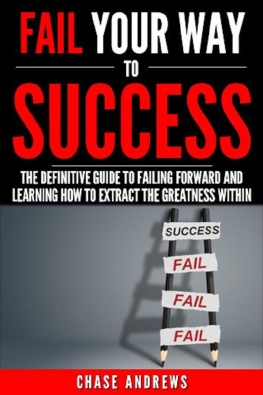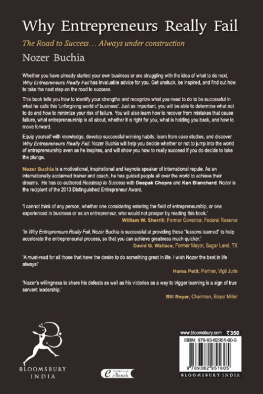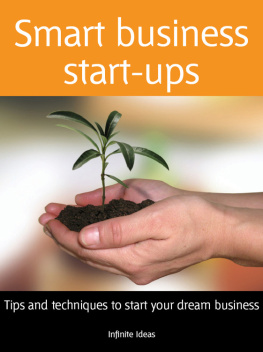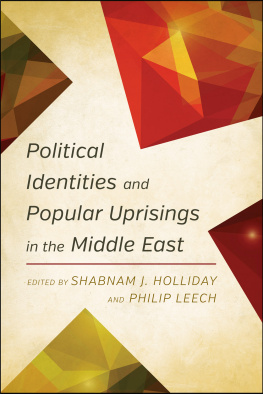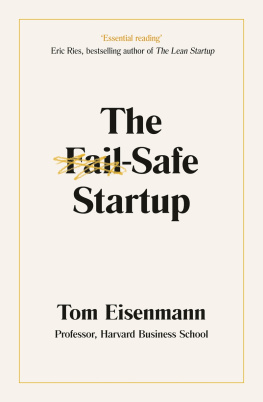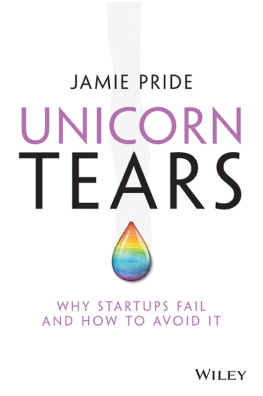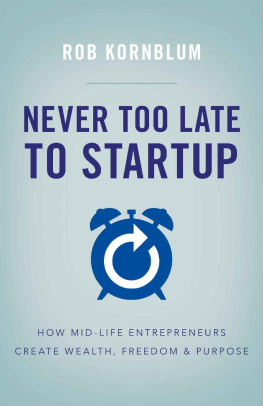Table of Contents


For Sereena, and all the little girls out there; dont be afraid to fail. Be afraid to not.
This is primarily a work of non-fiction. Some names, locations and detailshave been changed to protect peoples identities. Wherever possiblefor me to confirm details, I have done so, butmost of this book is based on my memory. GeoffDyer once wrote, Memory has a spottiness as if thefilm was sprinkled with developer instead of immersed in it.My story is true to my recollection of the eventsas they took place, but my confidence in the accuracyof my memory is impossibly high. I apologize in advanceto anyone whose memory film does not match up withmine. Namaste.
I continue to find my greatest pleasure, and so my reward, in the work that precedes what the world calls success.
Thomas A. Edison
CONTENTS
W hen I first started working on this book, I thought it would be one of those how-to-find-success-in-startups-and-in-life kind of books. I thought Id write about how I overcame adversity and failure and stepped out of the startup boxing ring with my head held high and my chest puffed out, jumping around like Rocky Balboa in Rocky III. I thought I would have found the magical pot of success gold at the end of the failure rainbow by now. I thought I would tell you about how I did it and how you can too.
Then I started the research. I picked up one book after another that said exactly that: 10 steps to startupsuccess! Follow these rules to build a great company! Heres how Steve Jobs did it. Learn from the best! But I had read many of these books while I was building my startup, and none of them helped me one bit back then.
These kinds of books were all trying to give me, the entrepreneur, pointers, to help me see potholes before I stepped into them, and give me answers to questions I didnt have yet. None of them helped me avoid failure, though. Worse, every single one was written by someone who had ultimately succeeded to grow or sell their business. None of them shut down, walked away, nor admitted to colossal loss.
I realized there was no way to help a budding entrepreneur avoid failure. It was inevitable, it would be painful, and it was, in fact, necessary for each of us to go through. My failures were the hardest moments of my life, but they shaped me 100 times more than my successes ever did. Even the final one.
So, I knew I would have to write about failure in my book. How could I write about my failures though? I was raised to hide my failures in a dark corner and shine a light on my successes. That was how I would climb the imaginary ladder to enduring success. I couldnt possibly tell the world, or even you, the one person who stumbled upon this book amongst the hundreds of others on the Amazon and Flipkart shelves, that I had failed. What would people say?
What was worse was how painful it was to relive those memories of failure while writing my book. Every time I sat down to write a story about how I failed in hiring, marketing, sales, fundraising, leadership, friendship, or even firing people, my hands froze and my heart yearned for me to run away from the page.
I have always had a deep and debilitating fear of failure. But my fear of people knowing I had failed was even more paralyzing.
It turned out that my memories of my failures were what psychologist Ulric Neisser calls flashbulb memories memories of shocking, emotional events that leave a particularly vivid imprint on your mind. William James, the father of American psychology, once described these imprints in 1890 as so exciting emotionally as almost to leave a scar upon the cerebral tissues. The memories are so detailed and vivid that its almost like a picture taken with a flashbulb, Elizabeth Phelps, a cognitive neuroscientist at NYU, says.
When I recalled the events that occurred while building my startup, I was scratching the scar tissue on my memory. Opening the wound up would hurt and talking about it on the page would feel almost as painful as living through the events in the first place.
However, research also shows that to recalibrate our brain to feel less extreme emotions of fear and pain with regards to an event, we need to explore the event. In fact, we need to explore it within whats called the vulnerability window. If we do, and if we do it right, we can recall the memory without experiencing the fear and emotions we once felt when the event occurred. We can even approach a similar event and feel no fear whatsoever.
That is how I wanted to feel about startups again. Writing each word, each page, each story of this book was my attempt to fall back in love with the starting up, building a business, failing at things, growing a team, and doing something meaningful with my life.
My hope is that over the next ten chapters of adventures in failure, we will both walk out of this boxing ring with our heads held high, our chests puffed out, and our fists up ready to fight the good fight again.
M y dear, incredible, beautiful team of superheroes,
Over the past two years, we have given this idea everything weve got. Weve given it our love, our time, our sweat, and even some of our tears. Weve showed up unannounced on doorsteps, weve bugged people at malls, cafes, and on the streets, and weve trampled through unknown territories searching for amazing teachers. Weve reached out and held the hands of hundreds of thousands of parents as they navigate the murky and confusing waters of their kids childhood. Weve supported thousands of small business owners and teachers as they grow their classes and teach more kids their talents. Weve even supported one another as weve grown and dealt with various personal and professional challenges, and weve truly thrived. Weve become the true definition of a team: a group of people who support and challenge one another through thick and thin, and stick together while growing in their own individual directions.
Some fun facts: Did you know weve made almost 6,000 direct connections between families and teachers across India? Did you know weve had parents visit us from 160 different countries and almost 3,000 different cities? (There are only 196 countries in the world, by the way.) Did you know that almost 50 per cent of our 3,60,000 users are actually dads? Did you know that 70 per cent of our users found us on their mobile phones and spent almost 1 minute using us? (Thats a lot in thumb-time.) Weve accomplished some amazing feats together, and come a long, long way from Day One, when we were hidden in the back-corner table of someone elses office!
Weve also made mistakes though. Did you know I once accidentally deleted our entire photo database of 10,000 listings? Did you know we once spent a crazy sum of money on a radio ad that was never actually aired? Did you know we once almost burnt the entire office down by leaving a light on overnight?
Weve struggled together to pick up from our numerous failures and weve walked through fire together, hand in hand, reaching great heights time and time again. Sometimes we faltered, sometimes we succeeded, but one thing I can say for sure is that weve never judged one another for trying, and that is a truly special culture weve built here at KleverKid that I am immensely proud of.
Unfortunately, every adventure must run its course, and every adventure has a beginning, a middle and an end. And this wonderful little adventure of ours has reached its end. I could try and list the reasons for why and how this adventure has reached its natural end, but I fear none of them can properly tell us what went right or wrong. Some might say it was purely external market factors: the market for startups has declined and we suffered from the impact. Some might say it was timing: we were too early (or too late) to enter a nascent and complex market. Some might say it was the idea: we were not focused enough (or too laser focused) to justify a scalable, sustainable product. Some might say it was the model: there is no proof yet that hyperlocal marketplaces work, profitably. Some might say it was me: I was too caught up in the expectations of selling a strong vision of the business rather than building a truly strong business.



